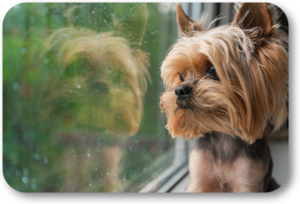I was at a new Home Dog Training client’s house in Atlanta yesterday working on their Yorkie’s separation anxiety and barking at things in the front of the house. These are two of the most numerous issues that we deal with on a daily basis. The separation anxiety is one that requires some extended work on the client’s part because of the long-term issues that normally cause it. Barking at the front window is typically a far easier issue to fix. Our client was very happy with the suggestions we offered, and we would like to share them with you.

One of the issues that we need to understand when dealing with our dog barking at people, cars, dogs, and other things passing in front of the house is to remember how they understand their location. After training for many years and visiting thousands of homes, I have noticed that many houses are built with the living room in the front of the house with a big picture window facing the street.
Most people put a sofa or chairs under the window and like to leave the drapes open to let in the sunshine and the view. Our dog perceives that our house is part of his safe area (or territory) and that beyond that are things that could possibly hurt or disrupt the rest of the family (or pack). When distractions pass in front of the house, it is very easy for our dog to see them and react. This is a natural action based on his instinct and is increasingly reinforced every time he does it.
Since we are not home all the time or not with our dog when he does it, we must think of ways to curb that action and to start to redirect his attention away from the front window and the distractions that cause this innate instinct. Once we break the action, we can redirect to what we would rather occur.
The first problem is our dog’s accessibility to the window and the view beyond. When our dog barks and goes crazy at the window, he is normally on the sofa with his nose to the window. He has a clear view of the outside and everything passing by. We need to block that visual stimulus in order to decrease his reaction. Simply put, we must diminish or block his view outside. The window is the initial problem. If you think about it, our dogs never bark and go crazy at a wall!
I suggest two, temporary solutions. I use the word “temporary” because as soon as we break the cycle, we can remove our “distraction blockers”. The first thing I would do is to keep our dog off the sofa.
You can try putting aluminum foil on the sofa pads. For some reason, many dogs hate the sound and feel of aluminum foil. It is like “fingernails across the black board” to us. If this doesn’t work, you can go to the dog store and get plastic pads that have raised bumps on one side that are very annoying to our dog’s paws. Place those on the sofa. As soon as our dog jumps on it, he will make the decision that this isn’t fun and will jump right off.
You can also use an old carpet/chair mat and cut it to size with an Exacto knife. The great thing about this solution is that it is allowing our dog to make his own decision about not getting on the sofa where he can easily see everything in front of the house and start to bark.
My other suggestion is based on “dogs normally don’t bark at things through walls”. All I want to do here is to physically block the window view. Many people just close the blinds to accomplish this. The only downside to this is that if our dog is excited and adrenalized, he might tear up or pull down the blinds. This is an expensive proposition. I suggest getting some cardboard and placing it along the bottom of the window so that when our dog looks at the window, he can only see the sky. This blocks the distractions on the street, allows light to enter the room, and removes the cost of replacing torn up blinds.
With these two suggestions, we have now kept our dog from jumping on the sofa and seeing “barkable” distractions in front of the house. Now we must give him something else to do. Put some of the dog’s favorite toys, chew bones, a Kong with frozen peanut butter, or other doggie goodies at the far end of the room.
If there is a TV, turn it on to help block the noise that might be coming from the front of the house. What we have done with this step is to provide an alternative choice for our dog’s activity. We are now allowing him to make the decision “I would rather do that”.
So, to review, what we have done is to:
- Keep our dog off the sofa.
- Don’t see the distractions outside.
- Give him something better to do.
These are passive actions that have worked for our clients numerous times in the past. The great thing about them is that they are easy and are in place 24/7. As always, proper leadership and focused training must go hand in hand with our passive solutions.
Please call Robin or me at (770) 718-7704 if you need any dog training help. We are blessed to have been your local dog training professionals for over seventeen years. We have trained over 5,000 great dogs and loving families and are ready to help you.

Follow Us!